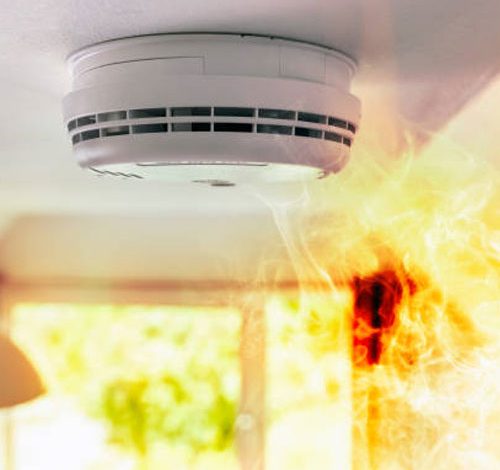Top 5 Fire Alarm Sensor Technologies You Should Know About
fire alarm sensor

When it comes to fire safety, choosing the right fire alarm sensor technology can be the difference between a minor incident and a devastating disaster. As one of the most critical components in a fire detection system, fire alarm sensors have evolved dramatically over the years, becoming more accurate, intelligent, and responsive.
At Sri Triveni Crafts, we are committed to offering state-of-the-art fire protection solutions tailored to your needs. In this blog, we’ll walk you through the top five fire alarm sensor technologies that are shaping modern fire safety and helping protect homes, businesses, and industries alike.
1. Ionization Smoke Detection Technology
How It Works:
Ionization smoke detectors use a small amount of radioactive material between two electrically charged plates, which creates a flow of ions. When smoke particles enter the chamber, they disrupt the flow of ions, reducing the current and triggering the alarm.
Best For:
Fast-flaming fires that produce small combustion particles, such as those caused by paper or flammable liquids.
Limitations:
They may not be as effective in detecting slow, smoldering fires and are more prone to false alarms from cooking or steam.
2. Photoelectric Smoke Detection Technology
How It Works:
Photoelectric detectors use a light beam inside a sensing chamber. When smoke enters, it scatters the light beam, which is detected by a sensor, activating the alarm.
Best For:
Smoldering fires that produce large smoke particles—typically caused by upholstery or electrical wiring.
This type of sensor is commonly integrated into fire smoke detectors used in residential and commercial fire alarm systems.
3. Heat Detection Technology
How It Works:
Heat sensors activate when the temperature in a room exceeds a preset threshold or when it rises rapidly over a short period. There are two main types:
-
Fixed Temperature Detectors – Trigger once a certain temperature (e.g., 135°F) is reached.
-
Rate-of-Rise Detectors – React to rapid increases in heat, regardless of the final temperature.
Best For:
Areas prone to dust, smoke, or steam where conventional smoke sensors might give false alarms—such as kitchens, warehouses, and garages.
Heat detectors are often integrated into automatic fire alarm systems to trigger immediate responses without human intervention.
4. Flame Detection Technology
How It Works:
Flame detectors use optical sensors to detect the ultraviolet (UV) or infrared (IR) light emitted by flames. These sensors are incredibly fast and can detect fire even before smoke or heat is present.
Best For:
High-risk industrial environments, fuel storage areas, and manufacturing facilities dealing with flammable materials.
These detectors are typically monitored and controlled via a fire alarm control panel and are part of a larger network within a fire alarm system.
5. Multi-Sensor (Hybrid) Technology
How It Works:
Multi-sensor or hybrid detectors combine two or more sensing technologies—such as smoke, heat, and carbon monoxide—in one unit. These devices use advanced algorithms to interpret multiple data points, reducing false alarms and increasing detection accuracy.
Best For:
Commercial buildings, hotels, hospitals, and other environments where both early detection and reliability are critical.
This technology is commonly connected to a central fire alarm panel for real-time monitoring and response coordination.
Why These Technologies Matter
Choosing the right fire alarm sensor technology depends on the environment you’re trying to protect. For example, a photoelectric sensor might be ideal for a living room, while an IR flame detector is better suited for a chemical plant.
When integrated into a comprehensive fire alarm system, each sensor type plays a key role in early detection and emergency response. At Sri Triveni Crafts, we work with businesses and homeowners to create customized fire protection plans using the most appropriate technology for each unique setting.
Conclusion
Fire safety has come a long way, and so has the technology behind it. From simple smoke detectors to advanced multi-sensor units, today’s fire alarm sensor technologies offer a level of protection that’s smarter, faster, and more reliable than ever before. The key is choosing the right one for your environment and ensuring it’s part of a well-designed and properly maintained fire alarm system.
At Sri Triveni Crafts, our mission is to make fire protection simple, efficient, and accessible. Whether you’re safeguarding a home or a multi-level industrial facility, we have the expertise and products to meet your needs.
Frequently Asked Questions (FAQs)
1. Which fire alarm sensor is best for home use?
Photoelectric smoke detectors are generally the best choice for homes due to their sensitivity to smoldering fires and lower false alarm rates.
2. How does a fire alarm panel help in a fire emergency?
The fire alarm panel receives signals from various sensors and controls the alarm system’s response, including sirens, alerts, and emergency contacts.
3. Can heat detectors replace smoke detectors?
Heat detectors are useful in environments where smoke may be present during normal activity, but they should be used in combination with fire smoke alarms for complete coverage.
4. What is the advantage of a multi-sensor fire alarm?
Multi-sensor alarms provide better accuracy and minimize false alarms by combining multiple types of detection in one device.
5. How do I know if I need an automatic fire alarm system?
If you’re managing a large commercial or industrial facility, an automatic fire alarm system offers real-time detection and response, ensuring safety even when staff is unavailable.



